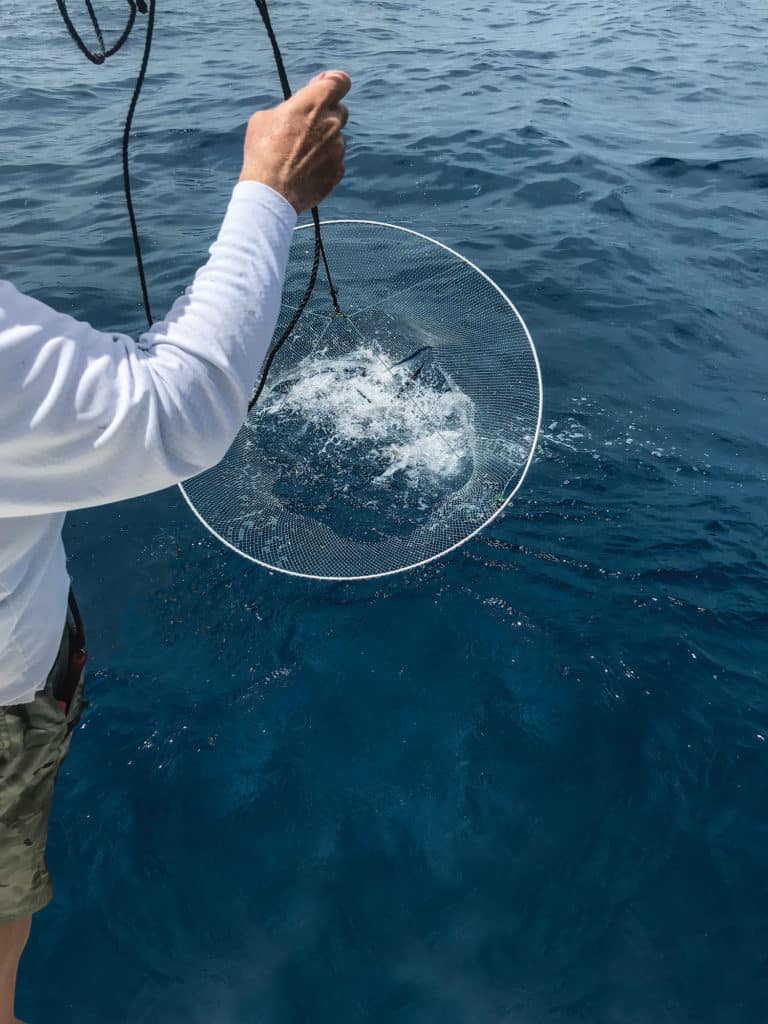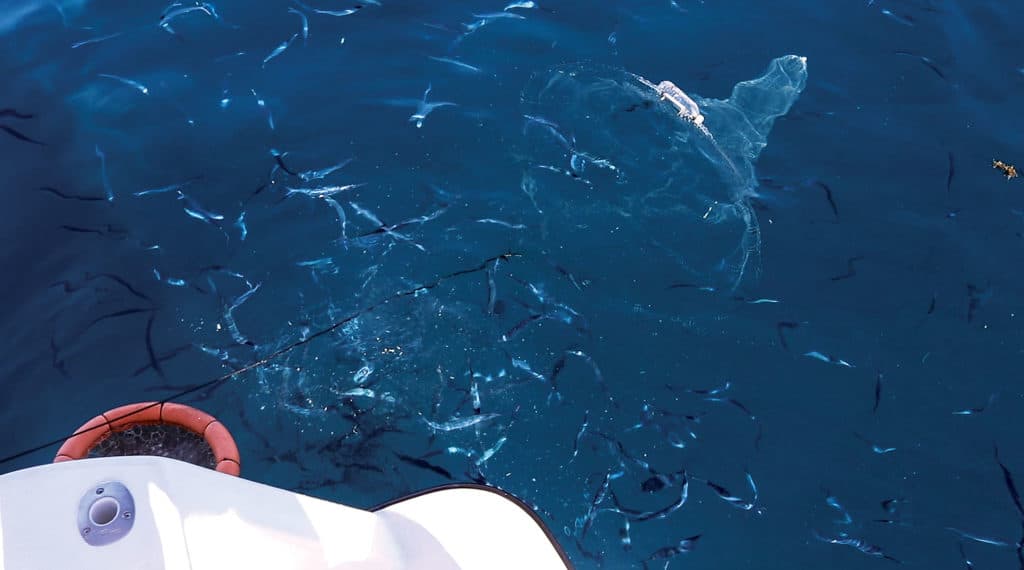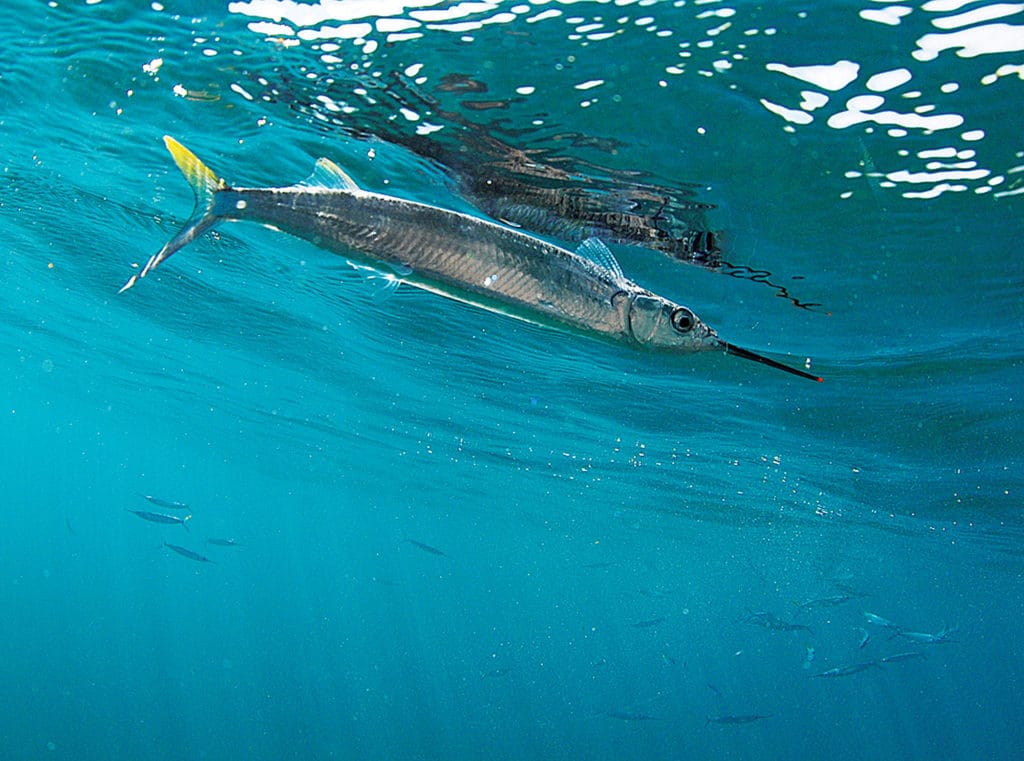
When anglers anywhere want to catch live bait, they commonly use a gold-hook rig or throw a cast net. But there’s a third option, one that originated among South Florida captains targeting ballyhoo: a hoop net.
All three methods carry pros and cons. Catching bait on a gold-hook or sabiki rig, which typically consists of six dressed hooks, can be quite effective, but the process can be painstakingly slow, especially when you’re catching only one baitfish at a time.
Cast nets catch bulk numbers in a single throw, but they can be difficult to fully open, and they can damage baits, removing scales and gilling the fish in the mesh.
Hoop nets catch fair amounts of bait and, when used properly, they don’t gill or scale bait. On the negative side: They can be difficult to store, given the size of their circular hoop. However, recent advances in hoop-net design have resolved that and are leading to increased popularity.

How Hoops Work
Different types of hoop nets have been used for years to catch everything from bait and food fish to lobsters and crabs. Commercial anglers use long, conical nets deployed in the water so fish swim into them. A crab hoop net is baited to attract the crustaceans; when a crab goes in to eat, the fishermen lift the net from the water.
Most hoop nets for catching bait — traditionally homemade or custom-made — include a solid, 4-foot-diameter fiberglass hoop with a 4- or 5-foot-deep mesh net and an attached line. The standard mesh size would be ¼-inch square, or ½-inch stretched, which makes the net less likely to gill the baits.
The captain chums up bait near the boat, and then places the net in the water, drifting it back behind and beneath the fish. He then pulls the hoop to the boat, capturing the fish.
Capt. Bunky Leach of Homestead, Florida, has long used hoop nets to catch ballyhoo, speedos, cigar minnows and other baitfish for charter trips on his boat Reef Reelief out of Ocean Reef Club in north Key Largo. Storing the net on the 37-foot sport-fisherman is not a problem
“I have plenty of room,” Leach says. “On a center-console, that could become an issue. When I had a center-console, I used to stick it on top of the T-top and bungee it down.”
Capt. Tony DiGiulian (saltwaterproconsulting.com) of Fort Lauderdale, Florida, says that while storage can be a challenge, a hoop net can often make the difference between having dozens of live baitfish or just a handful.
“Hoop nets are great for cigar minnows, speedos, threadfin herring, pilchards, anything that can be spooky,” DiGiulian says. “When we’re trying to catch those baits, we see them, we mark them, and they come up in the chum, but they can be very reluctant to eat our sabiki rigs.
“A lot of times, when ballyhoo, pilchards and other bait are on top, when you start to throw your cast net, they can see it coming, and they’ll scatter or dive right before it hits the water. You can’t catch as many at one time in a hoop net, but when bait is really sketchy and scared, it’s a good way to go.”

The Ballyhoop
Always a big fan of hoop nets, Yunior Dominguez of Hialeah, Florida, saw room for improving their design. In 2015, Dominguez, the owner of Piros Bait & Tackle, built a net with a one-piece stainless-steel hoop, which he said worked better than his fiberglass one because of its thinner diameter.
The ¼-inch steel could be retrieved through the water much faster than the ½-inch fiberglass. The steel hoop also held up better, and its silver color didn’t spook baitfish like the yellow fiberglass did. But the new version was still difficult to store.
Two years later, he designed a net with a collapsible two-piece aluminum hoop with male and female connections that stores in a half-moon-shape case and fits in most consoles or large hatches. He introduced the Ballyhoop (theballyhoop.com) at the 2017 ICAST fishing-tackle trade show in Orlando, Florida.
“It was a total success,” Dominguez says, “but I still kept getting people saying it was too big for their small boat.”
So he invented another version — all of his designs are patented — with a two-piece clear-polycarbonate hoop that stores like a two-piece fly rod. It can be placed upright in a rod holder or in a rod rack under a gunwale as well as in a console. Plus, because it’s clear, Dominguez says it doesn’t spook baitfish at all. And because it’s lightweight, any angler can use it easily and efficiently.
He adds that he has sold Ballyhoops — which retail online and at tackle stores for $200 (aluminum) and $300 (polycarbonate) — from Florida to Australia to Dubai, plus Costa Rica and Mexico. However, he hasn’t sold any in California, where he says hoop nets sometimes are used to catch Pacific mackerel baits. So far, he has no dealers in the state.

Hoop-Netting Tips
Dominguez says anglers should use finely ground chum to attract bait as opposed to chunks, which can get caught in the net’s mesh, causing baitfish to feed on it from behind the net. He uses Tournament Master Blue Label Chum, which is double ground.
“You have to control your chum. If you chum too much, the bait’s going to go all over the place and be hard to net,” adds Dominguez, who says to wait until the bait is eating the chum before putting the hoop net in the water. “Once they’re in that feeding frenzy mode, they don’t care. If you put the net in first, it could spook them.”
Leach, who uses a fiberglass hoop net, adjusts the position of the chum bag on his boat, moving it toward the bow if necessary to bring baitfish closer to the boat. If there’s too much current, he’ll attach a 1- to 5-ounce lead sinker to the bottom of the net with a clip so it sinks and keeps the net open.
“If you don’t have a weight on the net, a lot of times it wants to blow back on the hoop,” he explains, adding that he sometimes ties an overhand knot in the mesh to shorten the net. “That way we don’t put the bait all the way in the back of the net. The quicker you can put them in the livewell, the less scale damage you’ll have and the better they are. They just last a lot longer.
“When we’re fishing offshore for big game or even if we’re on the reef, we like to have good, healthy baits. Typically all the baits we have in the livewell at the end of the day we put in a bait tray and salt them up for the next day.”

If the current is light or nonexistent, a hoop net can sink too deeply. Dominguez, who has numerous bait-catching videos on the Ballyhoop Instagram page, attaches a half-filled clear-plastic water bottle with a rubber band to the hoop. “The bottle is buoyant enough so the net stays under the surface, but not way down,” he says.
The more you play with a hoop net, the more likely you’ll leave the sabikis and cast nets untouched.
“If you can get a hoop net to work, you’re going to do pretty well,” Leach says. “We went out for 30 minutes and caught 400 baits for a tournament.”








